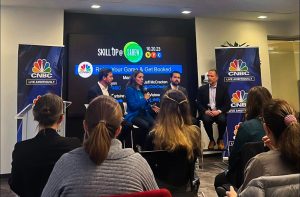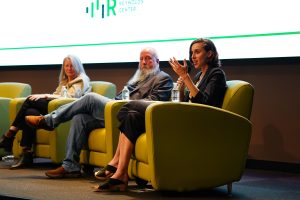One of the reasons I never made admiral of the Cox, Hearst, Gannett, Scripps-Howard or Knight Ridder navies is that I had a peculiar notion of how coverage should mostly be driven by reporters, rightly directed, rather than editors.
Thus, I would often push back against story ideas cooked up in the 10 a.m. meeting, where a bunch of people from the same socioeconomic background, suburban lifestyles and J-school degrees (no offense) would come out with “assignments.”
These almost always tended to be the kind of news mystery lunch meat made by committee, the “hey, this (rather banal) thing happened to me, find out why!” stories — as if a highly skilled business staff is your Q&A Guy — or the “localize this story that ran in _____.”
I would demur in my gentle, friend-winning way. I got away with it most of the time because I was usually brought in to turn around or improve the performance of business sections, at newspapers where business was a critical coverage area. It didn’t make me pals in certain places, but, as Mao would have put it, making an elite business section is not a dinner party.
Then we had to show results. We had to win our freedom of action every day.
‘HE’LL MAKE YOU GREAT’
My vision was built around reporters finding news as it was becoming. Before it was announced. Before the competition found it. And the news would have a certain quality: High impact, exclusive, sophisticated, sexy where possible, and the most important local story of the day (double points for national).
That meant developing a staff to produce this. The alternative was to localize a story asking people how they “felt” about rising bank fees. It was a powerful motivation.
In most cases, I was able to hire at least a couple of gunslingers with the skills, passion and hunger that could utterly change a department’s culture. I was fortunate to have a couple who followed me from one paper to another. Then I had to find the tunnel into each individual to identify strengths, areas of improvement and their own concerns — and see if he or she would join up for the changes I had in mind.
This last part was not hard if one treated people with respect and honesty, made them feel as if they were being heard, let them “win” occasionally (even if their way was less effective), praise more than find fault, and show them they were going to be part of something wonderful. “Unit pride” among experienced journalists was powerful. So was plenty of humor, with me as chief entertainer/comedian. Kicking ass is fun.
A big boss told a reporter complaining about my rigorous demands early on in my tenure (it always happened), “He’ll make you great.” This reporter became one of my biggest fans. But the boss was incorrect: The reporters, not me, made the section and the department great. I was just there to spin the wheel in the right direction.
GET OUT OF THE NEWSROOM!
That meant aiming beats most effectively. In some cases, beats were restructured, in others merely focusing better. Sometimes a beat went away, or one or two new ones were created. Other times, a reporter was assigned to an area that better fit her skills or interests. If something wasn’t broken, I didn’t break it. The process included many of the things I’ve discussed before in this space, such as covering touchstones and beat development.
Our morning meetings were brief and value-added — that was on me. A quick discussion of competing papers that morning, spread out on the conference table or brought up on a computer screen. Who beat us? Who did good work we should learn from? Competition and constant learning were critical. So were plenty of jokes and my probably tiresome lines (e.g., “Let’s kick the tires and light the fires”; “If we are not victorious, let no one come back alive”). Then a fast round-robin of stories coming that day. And any useful gossip about what was going on in the building.
Then we did indeed kick tires, light fires…Moving fast and effectively was important.

One major goal was getting reporters out of the newsroom. They needed to be in the executive suites, factory floors, industry conferences, union halls, groundbreakings, chamber of commerce events, trade shows, courthouses, neighborhoods — everywhere they could discover what was really happening, what was big, what was coming next. I believe this as strongly today with the Internet bringing so much to our computer screens. It’s a magnificent tool, a potentially dangerous distraction if not managed.
CHANNELING BEAR BRYANT
Coaching was another big goal. This extended from individual performance skills and giving honest evaluations and regular follow-ups, to brainstorming in advance how to approach a story, company or target-rich issue. This was not front-loading — a terrible practice, where the story’s outcome is determined in advance. Instead, it was a discussion of the area of inquiry and potential sources, questions and context. Then came follow-up discussions as the story jelled. It was far better to coach on the front end than fix on the back end. It also built expertise.
Coaching often extended to editors. For example, I was unforgiving about deadlines. But that meant a reporter deserved at least a first read and feedback within 15 minutes of when they filed. They needed to be back gathering, after all. Plus, it was part of the overall unit compact, where we had each others’ backs. Some assistant business editors needed to learn how to coach and inspire. A few inspired and taught me (Dom Cappa, among others, comes to mind).
The overarching ambition was to have the reporters generating high-value story ideas and stories. To be setting a news agenda that others had to chase.
This isn’t to say I never had an idea of my own, or that I didn’t do a top-down assignment because it was politically wise or, yes, actually a good story idea. And, yes, you will find inspiration and good story ideas on this site, even from me.
But in general the organic, grassroots, reporter-driven model produces the most effective journalism. It also sidesteps the groupthink that can infect our profession, where too often the news agenda for everybody is set by a few national sources.
And thanks to the superb journalists I had the honor to lead, I could almost always go into that 10 a.m. meeting with at least a couple of original stories that would carry the day.










